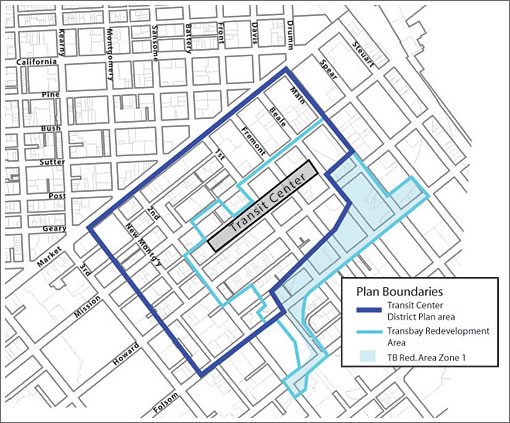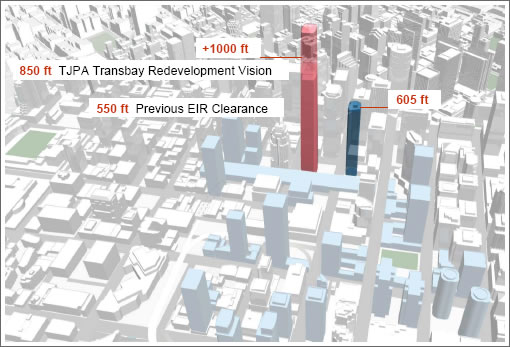
“Developers who construct skyscrapers and other buildings near the new Transbay Terminal in downtown San Francisco will have to pay up to $850 million in extra fees over a 20-year period, according to a city proposal announced Thursday.
The area will allow for towers taller than what is permitted downtown – including one building that could be up to 1,000 feet tall….The surcharges of up to $35 a square foot would be in addition to a package of downtown-only fees for things such as public transit, affordable housing and wastewater treatment.”

“The fees would be applied to all new developments, not just skyscrapers….Given the city’s lengthy planning and approval process, it is unlikely that any developer would obtain permission to build before 2011.”
∙ Extra fees for new transit district [SFGate]
∙ San Francisco’s Transbay Terminal: Website And Community Meeting [SocketSite]
∙ San Francisco’s Transit Center District Plan: EIR Notice Of Preparation [SocketSite]

What developer would WANT to build with those fees?! Isn’t this just the same as saying we don’t want to develop this area?
Typical SF. Changing the rules during the middle of the game. BOOOooo!!
Perfect City planning — let’s develop an area halfway, then kill it. Great idea. God forbid there should be any progress in an area that now primarily consists of vacant lots (that used to be entitled). Oh, and by the way, let’s impose these fees now when the economy is in the toilet and no one, under current conditions, would want to develop anything for 5 years anyway.
The City needs to do a reset since the global economic meltdown and expectations of an office economy “bubble” are very, very far in the future.
555 Mission street is probably the best new building in the city – it was started at the BEGINNING of the last boom economy and it is sitting near empty now. 100% location and a far lower cost psf than future towers.
Why would a tower 3x that size succeed? Who would lease it? Who would finance it ?
There is a better chance that a 1000 foot tall office building NEVER gets built than it gets built any time soon.
I dont think the city is tuned in enough to economic reality — or financial market reality – and that includes the job growth projections being stale.
Making a plan like this is a very costly process — just to get the planning done. If it yields no benefits because it remains unbuilt – it is just a bad use of our resources.
At this point, the city’s best investment would be to cast an entire neighborhood in Amber, let’s say North Becah / Fisherman’s Wharf … just to make sure that NOTHING, and I do mean NOTHING ever changes.
Why bother with asinine levies, fees and planning restrictions when you could just coat the whole place in durable, aesthetically pleasing amber?
Wrong Jimmy,
This is not an attempt at keeping the city where it is, this is a desperate attempt at grabbing money from any source it can, as the nation tries to deny that it is no longer as wealthy as it thought it was, and tries to keep spending like it was when it believed it was wealthy.
It’s only going to get worse, as cities and municipalities get more and more desperate for cash. You tax things that cannot leave the city or you’ll lose those things.
This doesn’t impact future developers a whit. What it means is that the price of lots in those areas just dropped by a nearly equivalent amount. Money has been confiscated from their owners and placed into the hands of the city to counter the massive outflow of taxes that is the natural reduction of a population who is no longer as wealthy as it thought.
As property taxes fall across the city due to 2003 valuations, the city is going to grab enough money to make it up. This is one of a long list of things they will do because the U.S. population is no longer as wealthy as it thought it was, but they don’t understand that yet and so their expectations of city services have not dropped proportionately. These things are all the cities can do!
“Welcome to Colonial Williamsburg.”
Tipster is kind of right IMO. What this really tells you is that the new Transbay Terminal is now 25 years out as opposed to 10 years out.
They have NO money, and after they’re done building the “Temporary Terminal”, it will be another 7 years before anyone starts tearing down the existing structure.
In the end all the city will have done is close a de facto homeless shelter/mentally ill ward.
All efforts have been to get someone to take a chance on the place. Designing it is no problem, you get paid for winning that poster contest, buying it and building it is a different story.
This is going to have the same effect as Sue Hestor’s Prop M. Nothing will get built for a decade +. At that point the ‘progressives’ will have run their doomed course, and when they do it’ll be open season for developers. When it does the pent up demand will overblow sensible growth once again.
God it is great having a town continuosly run by people who didn’t grow up here and don’t know what this place really means.
That ought to be enough to piss off all sides.
Louis hit the nail on the head. The City and planning don’t have a clue with respect to the real estate capital markets which are DEAD.
The lengthy approval process is a moot point. Don’t expect to see any major developments break ground for at least another 5 years. The only wild card being publicly funded projects.
you all have a lot of education with regards to what’s going on, what’s happened, and what’s being planned.
First of all, Ms Hestor’s beloved Prop M has made not one whisker of difference to anything in the City. It has not slowed down development one iota nor did it put any particular burdens on it, despite how vehemently she and her ilk defend it. The annual office limit (which Prop M did not create, to the contrary of popular lore — it existed before Prop M) was set at an amount coincident with the historic average annual office construction and absorption in the City. And because the unused annual limit is carried over every year, it means that the limit has never had a practical effect on anything. Let her defend it — who cares? It’s irrelevant.
Second, y’all don’t even know what’s being proposed in transbay, vis-a-vis fees, which is clear from your comments. The Chron article did a mediocre job of summarizing it, making broad generalizations which gave the wrong picture. The fees in the area are hardly being increased, and those additional $35 “extra” fees are mostly merely the result of reducing current other requirements (i.e. requiring developers to buy development rights from historic buildings) and subsituting a public fee instead, so it’s basically a wash because the two cost the same.
Third, @tipster had it about right. The new costs (which are mostly proposed Mello-Roos special taxes and property transfer fees), to the extent that they affect developments at all, mostly come out of the land value. But what do you think these fees are going for? They’re not for paying the general costs of government — they’re for paying to improve the infrastructure in the area of the developments, which in turn increases the value of the developments themselves. They’re getting something for the fees. Without them, the City wouldn’t have any money to systematically and thoroughly improve the area and build public infrastructure and it simply can’t and won’t be done by individual developments on their own volition. There are fees like this in Mission Bay and nearly every new neighborhood and subdivision throughout the state where dramatic densification or changes of use are happening. You can’t build a new place without providing new bones. The place is crap right now.
Fourth, these new fees are not being levied for nothing, for chrissakes people, they are coming in exchange for a MASSIVE upzoning. No fees, no upzoning. No upzoning, no fees. It’s that simple. These are not coming “in the middle of the game.” What a ridiculous statement. The entire premise of this planning effort to upzone the area was to leverage the additional development to raise more money. That was the whole point from day one.
Finally, yes, nothing will get built for 5 years (maybe more?), and it has nothing to do with development fees. Down cycles are the exact time to do long-range planning, not when the market is hot and the development pressure is on. Good planning is never done in hot market cycles, because tensions on all sides are so hot and time is short to make decisions. These plans have 25 year+ planning horizons. Everyone around here (by that I mean on this list and ones like it) fail to understand that the point of plans is not to ensure that things get built in the next 5-10 years. The City could eliminate all fees or even pay developers to build, and they still won’t build in the immediate term. But in the long term the fundamentals of growth are unshakable and will return, maybe not with a boom, but they will return.
Perhaps this explains why the Millennium is trying to milk its owners with $1,500 monthly HOA dues? Are they trying to cover their costs? I can’t see any other reason for the insanely high HOA dues.
Millenium is not at all subject to any of these new fees, which would apply only to new development built after the plan is adopted. (eg. beginning in 2011 or whenever).
can someone explain the supposed correlation between developer fees and HOA fees? how does a developer recoup its development costs by jacking up HOA fees? do the HOA fees go into the developer’s pockets somehow?